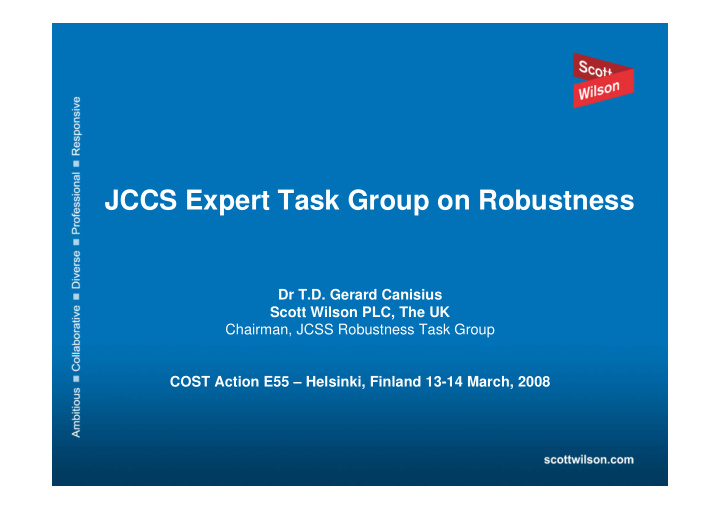



JCCS Expert Task Group on Robustness Dr T.D. Gerard Canisius Scott Wilson PLC, The UK Chairman, JCSS Robustness Task Group COST Action E55 – Helsinki, Finland 13-14 March, 2008
CONTENTS The Task Group � The contents of the Guidance Document on � Robustness
1. The JCSS Robustness Task Group � An outcome of � JCSS/IABSE International Workshop on Robustness � 28-29 November, 2005 at BRE � TG formed on 25 April 2006 � Develop International Guidelines Related to Robustness of Structures (Target July 2008)
2. JCSS Expert Task Group - Members Dr T.D. Gerard Canisius (Scot Wilson). Chairman 1. Prof. Michael Faber (ETH, Zurich) 2. Prof. John Sorensen (University of Aalborg, Denmark) 3. Mr Geoff Harding (formerly of DCLG, UK) 4. A. Maitra (Faber-Maunsell, UK) 5. R. Shipman (CLG, UK) 6. Prof. A. Vrouwenwelder (TNO, The Netherlands) 7. Prof. Bruce Ellingwood (Georgia Tech, USA) 8. Prof. Thomas Vogel (ETH, Zurich) 9. Dr John Menzies (Private Consultant) 10. Dr Fahim Sadek (NIST, USA) 11. Dr Finn Sorensen (Denmark) 12. Dr Jack Baker (Stanford University, USA) 13. Prof. Milan Holicky (Klockner Institute, Czech Rep.) 14.
� Observers Prof. Haig Gulvanessian (BRE) � Prof. Carmen Andrade (IETCC, Spain) � Dr Inger Kroon (COWI, Denmark) � Prof. A. Scherer (Univ. of Dresden, Germany) � � First Meeting – 5 th July 2006 (BRE) � Second Meeting – 23 rd November 2006 (Munich)
3. The JCSS Guidance Document: ‘Provision and Assessment of Structural Robustness’ The objective: To provide international state-of-the-art guidance on robustness issues By covering methods of quantifying, � assessing and � providing robustness, � and incorporating latest international thinking and knowledge.
The document directed more at � Regulators � Code Developers � R & D personnel � Can be used by practising engineers Scope � On-shore and near-shore structures, but not off- shore structures � Common structures (common rules & methods) & special structures.
CONTENTS Introduction 1. Philosophy and Principles of Robustness 2. Public Perception Issues 3. Hazards 1. Consequences 2. Definition of Structural Systems 3. Quantification of Robustness 4. Methods of Providing Robustness 1. Decision Making 2. Designing for Robustness 3. Effects of Quality Control and Deterioration on Robustness 1. Other Issues 2. Recommendations 3. Annexes 4.
4. Contents ( 12 chapters ) Chapter 1: Introduction Chapter 2: Philosophy and Principles of Robustness - A preamble, with historic approaches - Stakeholder requirements, especially in terms of existing practice and regulations
� Chapter 3: Public perception of robustness issues � Nature of structural safety � ‘tolerable risks’ � risk communication � risk acceptance � stakeholder participation in decision making � Chapter 4: Hazards � those considered by Regulations and codes � those not considered (including terrorist attacks)
� Chapter 5: Consequences � methods of quantifying consequences (human, structural, economical, political) � methods of expressing risks � proportionate consequences � Chapter 6: Definition of structural systems � from components to complete structures � inclusion of hazards and consequences in a system � sub-systems
Chapter 7: Quantification of robustness � what is robustness? � can we quantify numerically? � Can we help to compare two structures or solutions Chapter 8: Methods of providing robustness � How to make a system robust � Control of hazards � Good structural forms (topology) and properties (energy absorption) � Redundancy, stronger components � Inspection and maintenance
Chapter 9: Decision making � Strengthening costs vs accepting risks � Regulations � Optimisation � Legal issues � Dealing with public perception issues Chapter 10: Designing for Robustness � Framework for designing for robustness, considering � Hazards (prevent, control, compartmentalise) � Structure (strength, redundancy, energy absorption, maintenance) � Consequences (escape time & routes, contingency plans, emergency services) � Risks (Control/Minimise, Acceptable risk, Constraints)
Chapter 11: Effects of quality control and deterioration on robustness � Gross Errors � Material quality and fabrication errors. � Importance of maintenance. � Prevention.
� Chapter 12: Other issues � Robustness during construction. � Existing structures (The same principles apply) � Chapter 13: Recommendations � Annexes
Summary The JCSS has formed an Expert Task Group on � Robustness of Structures. The TG will produce a Guidance Document � Provision and Assessment of Structural Robustness The document, we believe, will be a major step � forward. We can look forward to it in the near future. �
Thank you.
Recommend
More recommend